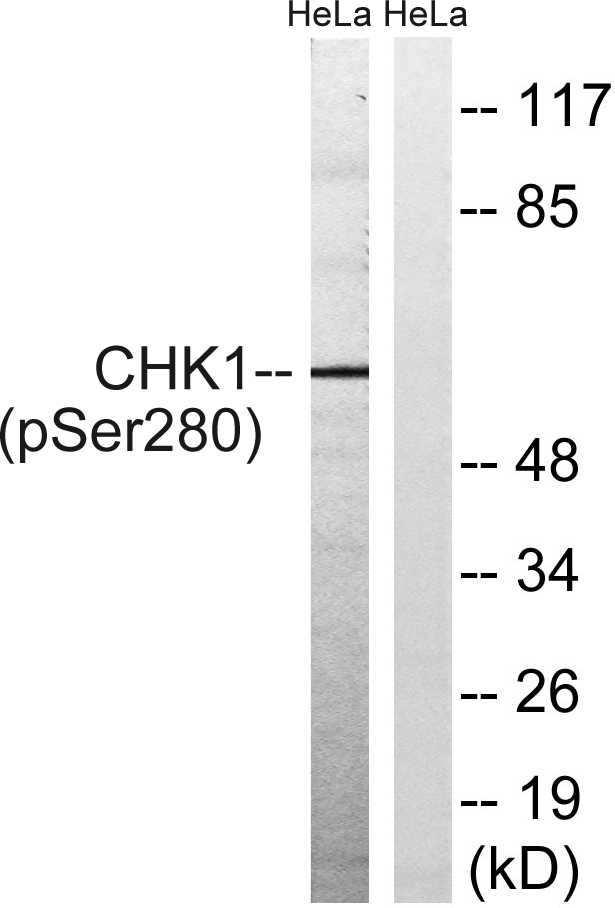Chk1 (phospho Ser280) Polyclonal Antibody
- Catalog No.:YP0061
- Applications:WB;ELISA
- Reactivity:Human;Rat;Mouse;
- Target:
- Chk1
- Fields:
- >>Cell cycle;>>p53 signaling pathway;>>Cellular senescence;>>Human T-cell leukemia virus 1 infection;>>Human immunodeficiency virus 1 infection;>>Viral carcinogenesis
- Gene Name:
- CHEK1
- Protein Name:
- Serine/threonine-protein kinase Chk1
- Human Gene Id:
- 1111
- Human Swiss Prot No:
- O14757
- Mouse Swiss Prot No:
- O35280
- Immunogen:
- The antiserum was produced against synthesized peptide derived from human Chk1 around the phosphorylation site of Ser280. AA range:251-300
- Specificity:
- Phospho-Chk1 (S280) Polyclonal Antibody detects endogenous levels of Chk1 protein only when phosphorylated at S280.
- Formulation:
- Liquid in PBS containing 50% glycerol, 0.5% BSA and 0.02% sodium azide.
- Source:
- Polyclonal, Rabbit,IgG
- Dilution:
- WB 1:500 - 1:2000. ELISA: 1:20000. Not yet tested in other applications.
- Purification:
- The antibody was affinity-purified from rabbit antiserum by affinity-chromatography using epitope-specific immunogen.
- Concentration:
- 1 mg/ml
- Storage Stability:
- -15°C to -25°C/1 year(Do not lower than -25°C)
- Other Name:
- CHEK1;CHK1;Serine/threonine-protein kinase Chk1;CHK1 checkpoint homolog;Cell cycle checkpoint kinase;Checkpoint kinase-1
- Observed Band(KD):
- 54kD
- Background:
- The protein encoded by this gene belongs to the Ser/Thr protein kinase family. It is required for checkpoint mediated cell cycle arrest in response to DNA damage or the presence of unreplicated DNA. This protein acts to integrate signals from ATM and ATR, two cell cycle proteins involved in DNA damage responses, that also associate with chromatin in meiotic prophase I. Phosphorylation of CDC25A protein phosphatase by this protein is required for cells to delay cell cycle progression in response to double-strand DNA breaks. Several alternatively spliced transcript variants have been found for this gene. [provided by RefSeq, Oct 2011],
- Function:
- catalytic activity:ATP + a protein = ADP + a phosphoprotein.,domain:The autoinhibitory region (AIR) inhibits the activity of the kinase domain.,function:Required for checkpoint mediated cell cycle arrest in response to DNA damage or the presence of unreplicated DNA. May also negatively regulate cell cycle progression during unperturbed cell cycles. Recognizes the substrate consensus sequence [R-X-X-S/T]. Binds to and phosphorylates CDC25A, CDC25B and CDC25C. Phosphorylation of CDC25A at 'Ser-178' and 'Thr-507' and phosphorylation of CDC25C at 'Ser-216' creates binding sites for 14-3-3 proteins which inhibit CDC25A and CDC25C. Phosphorylation of CDC25A at 'Ser-76', 'Ser-124', 'Ser-178', 'Ser-279' and 'Ser-293' promotes proteolysis of CDC25A. Inhibition of CDC25 activity leads to increased inhibitory tyrosine phosphorylation of CDK-cyclin complexes and blocks cell cycle progression. Binds
- Subcellular Location:
- Nucleus . Chromosome . Cytoplasm . Cytoplasm, cytoskeleton, microtubule organizing center, centrosome . Nuclear export is mediated at least in part by XPO1/CRM1 (PubMed:12676962). Also localizes to the centrosome specifically during interphase, where it may protect centrosomal CDC2 kinase from inappropriate activation by cytoplasmic CDC25B (PubMed:15311285). Proteolytic cleavage at the C-terminus by SPRTN promotes removal from chromatin (PubMed:31316063). .
- Expression:
- Expressed ubiquitously with the most abundant expression in thymus, testis, small intestine and colon.
- June 19-2018
- WESTERN IMMUNOBLOTTING PROTOCOL
- June 19-2018
- IMMUNOHISTOCHEMISTRY-PARAFFIN PROTOCOL
- June 19-2018
- IMMUNOFLUORESCENCE PROTOCOL
- September 08-2020
- FLOW-CYTOMEYRT-PROTOCOL
- May 20-2022
- Cell-Based ELISA│解您多样本WB检测之困扰
- July 13-2018
- CELL-BASED-ELISA-PROTOCOL-FOR-ACETYL-PROTEIN
- July 13-2018
- CELL-BASED-ELISA-PROTOCOL-FOR-PHOSPHO-PROTEIN
- July 13-2018
- Antibody-FAQs
- Products Images

- Western Blot analysis of 293T cells using Phospho-Chk1 (S280) Polyclonal Antibody diluted at 1:500

- Western blot analysis of lysates from HeLa cells treated with Hu 2nM 24hours, using Chk1 (Phospho-Ser280) Antibody. The lane on the right is blocked with the phospho peptide.



